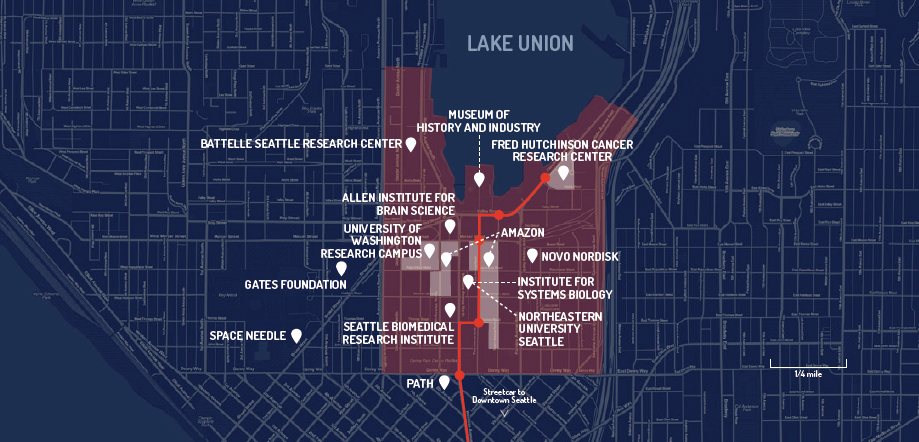Imagine a place where going to work means biking freely without the fear of cars to a coffee shop, where one collaborates with other people from nearby start-ups, research labs or universities. Sounds like a Portlandia episode? Truth is, a report released by the Brookings Institution’s Metropolitan Policy Program earlier this week states that such work environments are starting to emerge organically throughout the world – they’re called Innovation Districts.
These districts are defined as “geographic areas where anchor institutions and companies cluster and connect with small firms, startups, business incubators and accelerators.” Additionally, innovation districts are “physically compact, transit accessible, technically wired and offer a mix of housing, office and retail.”
Having a compact district where firms are near other firms, research labs and universities allows for “open innovation,” which is the sharing of ideas from “legal advice to sophisticated lab equipments.”
This environment, emerging particularly in the U.S. post Great Recession, is a far departure from the landscape of innovation that has dominated the past 50 years – suburban corridors of isolated corporate campuses, accessible mainly by car with little to no attention to integrating work, housing and recreation.
Here are six cities in the U.S. from East Coast to West Coast with areas that fit Brookings’ definition of Innovation District (and to learn more about each, take a look at Brookings' visually compelling report here):
1. Boston: Innovation District
2. Philadelphia: University City
3. Raleigh–Durham: Research Triangle Park
4. Detroit: Downtown, Midtown
5. St. Louis: Cortex
6. Seattle: South Lake Union
Related Stories
| Nov 15, 2010
Gilbane to acquire W.G. Mills, Inc.
Rhode Island-based Gilbane Building Company announced plans to acquire W.G. Mills, Inc., a construction management firm with operations based in Florida. The acquisition will dramatically strengthen Gilbane’s position in Florida’s growing market and complement its already established presence in the southeast.
| Nov 11, 2010
Saint-Gobain to make $80 million investment in SAGE Electrochromics
Saint-Gobain, one of the world’s largest glass and construction material manufacturers, is making a strategic equity investment in SAGE Electrochromics to make electronically tintable “dynamic glass” an affordable, mass-market product, ushering in a new era of energy-saving buildings.
| Nov 11, 2010
Saint-Gobain to make $80 million investment in SAGE Electrochromics
Saint-Gobain, one of the world’s largest glass and construction material manufacturers, is making a strategic equity investment in SAGE Electrochromics to make electronically tintable “dynamic glass” an affordable, mass-market product, ushering in a new era of energy-saving buildings.
| Nov 11, 2010
USGBC certifies more than 1 billion square feet of commercial space
This month, the total footprint of commercial projects certified under the U.S. Green Building Council’s LEED Green Building Rating System surpassed one billion square feet. Another six billion square feet of projects are registered and currently working toward LEED certification around the world. Since 2000, more than 36,000 commercial projects and 38,000 single-family homes have participated in LEED.
| Nov 10, 2010
$700 million plan to restore the National Mall
The National Mall—known as America’s front yard—is being targeted for a massive rehab and restoration that could cost as much as $700 million (it’s estimated that the Mall has $400 million in deferred maintenance alone). A few of the proposed projects: refurbishing the Grant Memorial, replacing the Capitol Reflecting Pool with a smaller pool or fountain, reconstructing the Constitution Gardens lake and constructing a multipurpose visitor center, and replacing the Sylvan Theater near the Washington Monument with a new multipurpose facility.
| Nov 9, 2010
Just how green is that college campus?
The College Sustainability Report Card 2011 evaluated colleges and universities in the U.S. and Canada with the 300 largest endowments—plus 22 others that asked to be included in the GreenReportCard.org study—on nine categories, including climate change, energy use, green building, and investment priorities. More than half (56%) earned a B or better, but 6% got a D. Can you guess which is the greenest of these: UC San Diego, Dickinson College, University of Calgary, and Dartmouth? Hint: The Red Devil has turned green.
| Nov 9, 2010
12 incredible objects being made with 3D printers today
BD+C has reported on how 3D printers are attracting the attention of AEC firms. Now you can see how other creative types are utilizing this fascinating printing technology. Among the printed items: King Tut’s remains, designer shoes, and the world’s smallest Rubik’s Cube.
| Nov 9, 2010
U.S. Army steps up requirements for greening building
Cool roofs, solar water heating, and advanced metering are among energy-efficiency elements that will have to be used in new permanent Army buildings in the U.S. and abroad starting in FY 2013. Designs for new construction and major renovations will incorporate sustainable design and development principles contained in ASHRAE 189.1.















